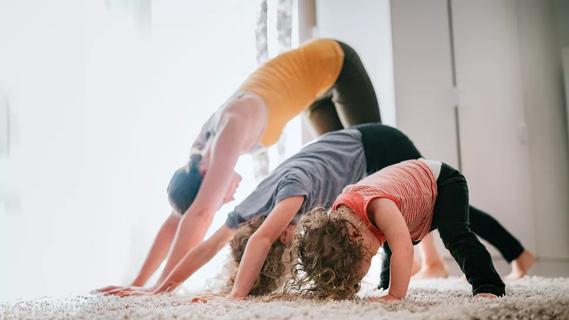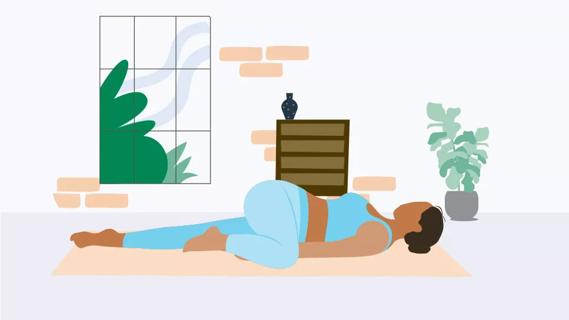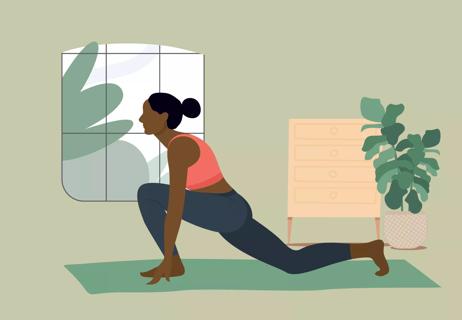Soap and water will do the trick, but only consider disinfecting if you share a mat

At the end of a long hard day, a yoga lesson is exactly what you need to destress and reconnect with your body. After a session of challenging poses, the instructor invites you to assume child’s pose and focus on your breathing. As you do, a thought occurs to you: What exactly are you breathing in? And touching? Is the yoga mat you’re currently sweating on dirty or germ-ridden?
Advertisement
Cleveland Clinic is a non-profit academic medical center. Advertising on our site helps support our mission. We do not endorse non-Cleveland Clinic products or services. Policy
It’s an understandable concern. The internet is rife with articles about the microbes lurking on your yoga mat. Those articles usually include links to pricey yoga mat sprays or recipes for homemade, natural cleansers. Some websites even recommend cleaning your mat after every use. But do you really need to do that?
Only if you’re sharing your mat with other people, says yoga instructor and retired pediatrician Johanna Goldfarb, MD.
“If you’re using your own mat, you really shouldn’t worry about contamination,” she says. “I’m more likely to clean it because it’s dirty than because I’m worried about infection.”
When a mat is dirty — following an outdoor session, for example — giving it a simple cleaning is a good idea. For this, soap and water are enough. To clean:
So, how often should you be giving your mat a soap-and-water cleansing? Probably not as often as you think. A personal mat only needs to be cleaned when it’s visibly dirty, Dr. Goldfarb advises.
But what about germs — do you ever need to disinfect your mat?
You only need to if you’re using a shared mat.
The distinction between cleaning and disinfecting something is important — and often misunderstood. According to the Centers for Disease Control and Prevention (CDC):
Advertisement
According to Dr. Goldfarb, unless you have a skin infection, cleaning your personal yoga mat with soap and water will get rid of any microbes you might encounter in your own home. Shared yoga mats — especially at a gym — are a different story.
If you’ve been to a gym, you’ve seen the towels and spray bottles scattered throughout the space. They’re there for a reason.
“Disinfection is something we do in a gym setting because we don’t know what could be there,” Dr. Goldfarb explains. Viruses like herpes simplex and bacteria like Staphylococcus aureus can survive on surfaces. For that reason, it’s wise to use a chemical disinfectant on a shared yoga mat.
In other words, you should treat yoga mats like you would any gym equipment. Disinfecting the mat before you use it will help protect you from infection. Disinfecting the mat when you’re done with it will help protect other gym-goers from anything you’re carrying. And it’s best to use the disinfectant spray the gym provides, so as not to risk damaging the equipment.
No doubt, some of you are reading this article and thinking, “I’m still going to disinfect my yoga mat.” It’s an understandable impulse, especially right now. Most of us got more serious about disinfecting surfaces when COVID-19 arrived on the scene. For some, it’s become a habit.
Unfortunately, studies show that we haven’t been as cautious in our use of hazardous chemicals as we should be. Calls to Poison Control Centers skyrocketed all over the country in 2020. One CDC study shows that up to one-third of us have used chemicals unsafely while trying to protect ourselves and our families from the virus.
If you’re dead set on using a disinfectant on your yoga mat, Dr. Goldfarb urges to “make sure you know what you’re using.” Many cleaners aren’t safe, and — depending on the material your yoga mat is made of — some disinfectants could destroy it. In that case, your efforts to eliminate microbes are likely more dangerous than the microbes themselves. When in doubt, stick with ol’ reliable soap and water.
Are there microbes on your yoga mat? Yes. Are there also microbes on you, and everything else you interact with on a daily basis? Also yes and yes. That’s not a bad thing. So, if you’re wondering whether or not to clean or disinfect your yoga mat, remember that common sense is a powerful weapon in the war against infection.
Advertisement
Dr. Goldfarb reminds us: “The most important way to prevent getting infected from gym equipment of any kind — yoga mats included — is to wash your hands after you leave the gym. Don’t touch your eyes or face. If you have to sneeze, sneeze into your arm so that your germs don’t get on the equipment. Remember to clean the equipment immediately with the towels and solution the gym provides.”
If you’re taking yoga classes indoors right now, you should also be wearing a mask. It’s unlikely you’ll contract viruses like COVID-19 or influenza from your yoga mat. Unfortunately, the same can’t be said of your fellow practitioners — most respiratory infections are transmitted person-to-person.
Rest assured — the benefits of practicing yoga far outweigh any risk posed by the microbes on your gear. So, unroll your mat and get flowing!
Advertisement
Learn more about our editorial process.
Advertisement

Kids’ yoga can help kiddos become more aware of their physical, mental and emotional selves

This mindful practice is designed to give you mental and physical relaxation

Both practices are worth exploring and offer amazing health benefits

You can work more than your abdominals

From using props to practicing on the go, yoga offers an array of benefits

Select a yoga class that focuses on your breath and promotes kindness toward yourself

The healing benefits of trauma-informed practices

Find out how they can help at any level

Type 2 diabetes isn’t inevitable with these dietary changes

Applying a hot or cold compress can help with pain